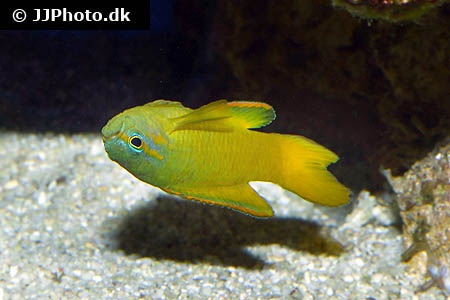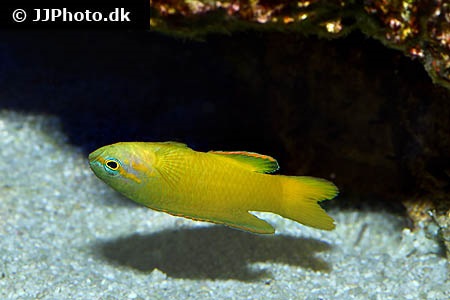Assessor flavissimus


| Latin name | Assessor flavissimus - Allen & Kuiter, 1976 |
|---|---|
| Local name | Yellow devilfish |
| Family | Plesiopidae - Assessor |
| Origin | |
| Max length | 6 cm (2.4") |
| Minimum volume |
50 l (13 gal) |
|---|---|
| Hardiness |
Hardy |
| Suitable for aquarium |
Suitable for most aquarium |
| Reef safe |
Always reef safe |
| Aggressiveness | Mostly peaceful but might be aggressive towards similar species |
| Recommended |
Small crustaceans (Krill, mysis, artemia...) Zooplankton (Cyclops, pods...) |
|---|
They can live as a pair provided they are introduced simultaneously.
This species needs good hiding places, for example, between live rocks.
This species is very shy and docile, so one should be careful when keeping it with more aggressive fish.
Known to occasionally swim upside down.
There are several intriguing species of Roundheads (Plesiopidae) which are both interesting and easy to keep.
In the wild, most species will stay hidden and hunt at night, they mimic this behaviour in the aquarium so they are not often seen during daylight hours, although they will appear more in time.
These fish are generally quite hardy if given a varied diet.
They are not well suited to tanks with fast or aggressive fish, as they might hide and therefore not get sufficient food.
One should avoid keeping them with Hawkfish, Triggerfish and aggressive Wrasses for example.
Below are short descriptions of the species most suited to aquaria.
Assessors
Pretty, small fish that somewhat resemble Grammas and Dottybacks.
They are hardy, max. 2.5 inches (6 cm) and reasonably peaceful. Suitable for both coral and nano aquariums.
Calloplesiops
A unique fish which is hardy when fed correctly, but does require extra attention when adjusting to life in captivity. They will not thrive when kept together with aggressive species.
Plesiops
These fish are very aggressive and not often seen in aquaria.
Most species do not get very big and can therefore be kept in smaller tanks.
| Aquarium trade | Yes |
|---|---|
| Distribution | Western Central Pacific: Great Barrier Reef and Papua New Guinea. |
| English common names |
Yellow devilfish Yellow scissortail |
Scott W. Michael. 2001. Basslets, Dottybacks & Hawkfishes: v. 2 (Reef Fishes) - TFH Publications / Microcosm Ltd. - (English)
Bob Fenner. The Roundheads: (for petfish types mainly Assessors), Family Plesiopidae - Wet Web Media - (English)

